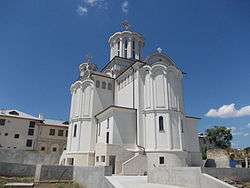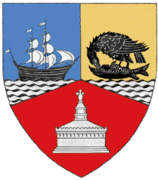Techirghiol
| Techirghiol | |
|---|---|
| Town | |
 | |
 Location of Techirghiol | |
| Coordinates: 44°3′27″N 28°35′45″E / 44.05750°N 28.59583°ECoordinates: 44°3′27″N 28°35′45″E / 44.05750°N 28.59583°E | |
| Country |
|
| County | Constanța County |
| Status | Town |
| Government | |
| • Mayor | Iulian Constantin Soceanu[1] (National Liberal Party) |
| Area | |
| • Total | 46.07 km2 (17.79 sq mi) |
| Population (2011[2]) | |
| • Total |
|
| Time zone | EET (UTC+2) |
| • Summer (DST) | EEST (UTC+3) |
| Website | http://www.primaria-techirghiol.ro/ |
Techirghiol (Romanian pronunciation: [ˈtekirɡjol], historical name: Tekirgöl) is a town in Constanţa County, Romania.
Etymology
The name is derived from the Turkish Tekirgöl which means "the lake of Tekir". According to a legend, a blind and crippled old man named Tekir and his old donkey reached the shore of the lake by mistake. Trying to pull his stubborn animal out of the mud, Tekir was miraculously healed so he could see and walk normally again. Since then the lake has become famous for its healing properties.
Tekir and his donkey are featured in a statue located in the center of the town.
The name also means (in Turkish) "Striped Lake" (tekir - striped, and göl - lake). This is because of the salinity of the lake; when the wind blows, white salt stripes appear on the surface of the lake.
Location
Town is in the south east extremity of Romania (Constanța County), situated on the north west shore of Lake Techirghiol (11.6 km2), elevation 15–20 m, 18 km south of the municipality of Constanța and very close to the Black Sea (3 km).
In Techirghiol the winters are mild and the summers are warm, dominant being the clear skies (the sun shines for more than 2,400 hours every year).
History
Techirghiol was first marked on the country's map in 1893 but developed steadily after 1912, establishing itself as a spa town.
In 1891, Hagi Pandele opened its doors, the first hotel and cold baths establishment in the town. In 1900 the extraction of therapeutic mud initiated and this led to the construction of many bathing establishments and hotels.
After World War I, in 1920, Techirghiol started to become a very popular tourist attraction due to its famous therapeutic mud.
Techirghiol Balneotherapy Center
The sapropelic mud from the Techirghiol Lake is the jewel of the resort. In 1924, at the Universal Exposition from Paris, the Techirghiol mud received the golden medal. Alphons Saligny was the first to study the therapeutic use of the mud; after this the Romanian Institute of Balneology approved it and during the 1930s the studies realized by Alphons Saligny and the Institute were the base for solid scientific proof regarding the therapeutic actions of the sapropelic mud of Techirghiol and the methodology of those treatments.
The sapropelic mud of Techirghiol is used warm for different kind of procedures:
The use of therapeutic mud is also recommended for:
- Better skin elasticity,
- Hydration for cell strengthening and for dryness prevention.
- Skin healing (in cases of psoriasis and eczema)
- A better state of well-being and relaxation
- Improvement of pain from anterior accidents, as well as those from rheumatism and muscular immobility.
- General detoxification of the organism can easily be achieved after a series of general massages with mud, or after a cure of wrappings in the comfort of your own home, or in a specialized saloon, or on the seashore.
Places of interest
- Lake Techirghiol
- Saint Mary Monastery
- Techirghiol Balneotherapy Center
Demographics
| Historical population | ||
|---|---|---|
| Year | Pop. | ±% |
| 1930 | 1,956 | — |
| 1948 | 2,136 | +9.2% |
| 1956 | 2,705 | +26.6% |
| 1966 | 4,643 | +71.6% |
| 1977 | 9,706 | +109.0% |
| 1992 | 6,872 | −29.2% |
| 2002 | 7,388 | +7.5% |
| 2011 | 6,845 | −7.3% |
| Source: Census data | ||
At the 2011 census, Techirghiol had 5,646 Romanians (82.48%), 8 Hungarians (0.12%), 27 Roma (0.39%), 336 Turks (4.91%), 615 Tatars (8.98%), 6 Lipovans (0.09%), 17 Aromanians (0.25%), 184 others (2.69%), 6 with undeclared ethnicity (0.09%).
Notable natives
- Jean Constantin, Romanian actor
References
- ↑ "Rezultate finale în judeţul Constanţa. Iată care sunt noii primari din judeţ!" (in Romanian). Ziua de Constanța. 6 June 2016. Retrieved 6 June 2016.
- ↑ "Constanta County at the 2011 census" (PDF) (in Romanian). INSSE. 2 February 2012. Retrieved 7 April 2016.
External links
| Wikimedia Commons has media related to Techirghiol. |
- Techirghiol weather forecast and weather conditions
- Alternative website about Techirghiol
- Legends of Techirghiol
- Techirghiol Balneotherapy Center
- Saint Mary Monastery
